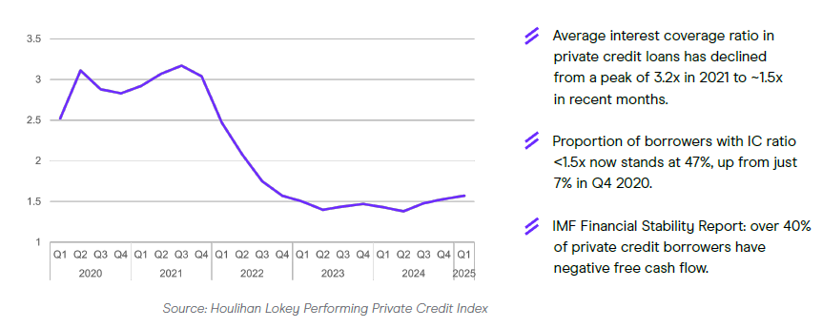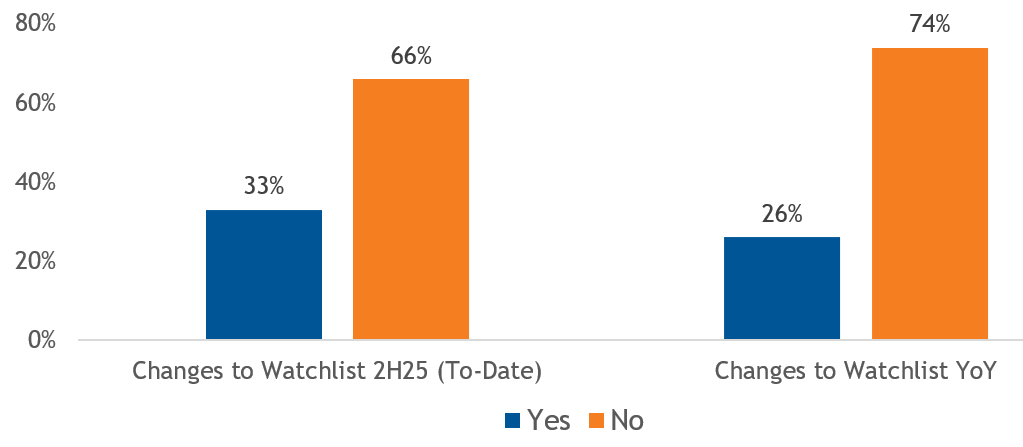
Image Source: Pixabay
Private credit’s rapid growth faces its first real test
Private credit has rapidly grown to be a leading source for corporate lending, representing more than $2 trillion in assets under management. However, in the wake of a few recent borrower defaults and headlines in select sectors, there has been debate as to whether these represent cracks in the system or are simply isolated events.
As the chart shows, the rise of private credit has been dramatic, underscoring how material the market has become to institutional portfolios. Yet scale alone doesn’t make it systemic. These defaults stem largely from alleged fraud and sector-specific shocks rather than broad deterioration in credit quality.
Private credit AUM has quadrupled since 2014
AUM in USD billions

Source: Preqin, Bloomberg, Russell Investments analysis
Borrowers are feeling the squeeze
The data does show some softening in borrower fundamentals. Interest coverage ratios have declined, free cash flow has weakened, and the share of payment-in-kind (PIK) income has risen. These are classic indicators of tightening financial conditions.
Still, context matters. As of November 2025, for most borrowers, this reflects a normal adjustment to higher rates, not widespread distress. Defaults are rising, but from a very low base. As illustrated, the average interest coverage ratio has fallen meaningfully—yet remains above pre-pandemic levels.
Average interest coverage ratio and share of PIK income across BDCs.
(Click on image to enlarge)

Stress contained within private markets
Despite localized strains, there’s little evidence private credit stress has spilled into public markets. Listed business development companies (BDCs)—a reasonable proxy for private credit performance—have softened modestly but stabilized in recent months. High-yield spreads, another important barometer, remain near their year-to-date averages.
Managers we engage report a similar story: A few challenged borrowers, limited contagion, and healthy levels of interest coverage overall. Transparency is improving as institutional allocators demand more detailed loan-level data and tighter documentation standards as well
Importantly, our recent survey of funded managers show most private-credit GPs (general partners) report stable or improving portfolio quality. According to a review of the internal watchlist for each of our managers, the majority of GPs have actually seen declines in the number of monitored credits, and several managers currently have no watchlist positions. Our survey reported only isolated, sector-specific names which have shown any deterioration, with most managers indicating issues are not expected to lead to material losses.
Changes to watchlist composition from Russell Investments’ private credit managers
(Click on image to enlarge)

Source: Russell Investments. Date through November 7, 2025.
Credit fundamentals remain sound: Among managers surveyed, leverage averages roughly 4.9× Debt / TTM EBITDA and interest coverage about 2.3× across portfolios, leaving borrowers with adequate service cushions even under tighter financial conditions. We do see dispersion widening. Managers are conducting what many describe as “full portfolio scrubs,” reflecting a proactive stance toward credit surveillance and documentation discipline rather than reactive distress management.
In short, the system looks similar to isolated events in other markets rather than a “Bear Stearns moment” signaling systemic breakdown.
Please note while data and manager commentary are current as of November 2025, conditions may evolve.
Private credit proxies vs. high-yield spreads
Global high yield OAS

Source: Bloomberg, Russell Investments analysis.
Watchpoints and the road ahead
While we believe current stresses are idiosyncratic, certain risk markers deserve continued attention. Liquidity constraints in semi-liquid vehicles, slower fundraising, and valuation disputes could amplify pressure if macro conditions tighten.
At the same time, the manager behavior shift revealed in our recent survey is notable: GPs are transitioning to forensic oversight, tightening credit standards and reassessing loan protections in specific sub-markets. This diagnostic approach underscores an industry that remains healthy but alert—focused on preserving value through disciplined monitoring rather than aggressive growth.
The chart below outlines these watchpoints—from borrower quality and funding liquidity to valuation discipline. Each represents a possible transmission channel if local cracks were to widen. For now, though, these remain monitoring points rather than catalysts for systemic stress.
PRIVATE CREDIT RISK WATCHPOINTS
Borrowers & Collateral
- Deterioration in interest coverage and free cash flow across portfolios.
- Rising use of PIK, amend-and-extend, and liability-management deals.
- Increasing number of opaque collateral, fraud, or double-pledging cases across similar structures.
Funding & Liquidity
- Potential constraints on liquidity: gates or delays in semi-liquid private credit funds.
- Challenges in fundraising activity.
Valuation
- Sudden NAV cuts or restatements at major platforms.
- Disputes over collateral quality or perfection of security.
We continue to monitor these areas closely.
Investor implications
For credit and fixed income investors, the message is one of cautious confidence. We believe recent defaults are isolated, not the start of a broader credit cycle downturn. Still, selective positioning and disciplined liquidity management are key.
We believe investors should focus on:
- Diversifying across managers, vintages, and deal types to mitigate idiosyncratic exposure.
- Prioritizing transparency in documentation and valuation practices.
- Maintaining appropriate liquidity buffers within semi-liquid structures.
In our view, private credit remains an attractive income source — provided investors remain vigilant and active in monitoring the evolving landscape.
More By This Author:
Markets Retreat As Investors Reassess Valuations
The Holiday Trading Effect: Timing, Liquidity And Investor Impact
Investor Focus Shifts To Fed Rate Outlook
Disclosure: Important information pertaining to the hypothetical example: Past performance does not predict future returns. Return level is proportionately scaled in line with cash level to be ...
more
Disclosure: Important information pertaining to the hypothetical example: Past performance does not predict future returns. Return level is proportionately scaled in line with cash level to be overlaid. Source: Russell Investments. Assumptions: Average cash level 1.0%, 10-year history from 12/31/2023, gross of fees. Opportunity cost from not securitizing cash varies by asset allocation and time period, and is represented by horizontal bars as marked within the chart legend. Target asset allocation used: 0% cash, 74% MSCI World, 26% Global Aggregate (GBP Hedged). For illustrative purposes only. Does not represent any actual investment. Indexes are unmanaged and cannot be invested in directly. Performance benefit (net) of overlaying cash by last 5 individual calendar year is as follows: 2023:20 bps, 2022:-17bps, 2021:16bps, 2020:14bps, 2019:23bps.
These views are subject to change at any time based upon market or other conditions and are current as of the date at the top of the page. The information, analysis, and opinions expressed herein are for general information only and are not intended to provide specific advice or recommendations for any individual or entity.
This material is not an offer, solicitation or recommendation to purchase any security.
Forecasting represents predictions of market prices and/or volume patterns utilizing varying analytical data. It is not representative of a projection of the stock market, or of any specific investment.
Nothing contained in this material is intended to constitute legal, tax, securities or investment advice, nor an opinion regarding the appropriateness of any investment. The general information contained in this publication should not be acted upon without obtaining specific legal, tax and investment advice from a licensed professional.
Diversification and strategic asset allocation do not assure a profit or guarantee against loss in declining markets.
Please remember that all investments carry some level of risk, including the potential loss of principal invested. They do not typically grow at an even rate of return and may experience negative growth. As with any type of portfolio structuring, attempting to reduce risk and increase return could, at certain times, unintentionally reduce returns.
The Russell Investments logo is a trademark and service mark of Russell Investments
The information, analyses and opinions set forth herein are intended to serve as general information only and should not be relied upon by any individual or entity as advice or recommendations specific to that individual entity. Anyone using this material should consult with their own attorney, accountant, financial or tax adviser or consultants on whom they rely for investment advice specific to their own circumstances.
Products and services described on this website are intended for United States residents only. Nothing contained in this material is intended to constitute legal, tax, securities, or investment advice, nor an opinion regarding the appropriateness of any investment, nor a solicitation of any type. The general information contained on this website should not be acted upon without obtaining specific legal, tax, and investment advice from a licensed professional. Persons outside the United States may find more information about products and services available within their jurisdictions by going to Russell Investments' Worldwide site.
Russell Investments is committed to ensuring digital accessibility for people with disabilities. We are continually improving the user experience for everyone, and applying the relevant accessibility standards.
Russell Investments' ownership is composed of a majority stake held by funds managed by TA Associates Management, L.P., with a significant minority stake held by funds managed by Reverence Capital Partners, L.P. Certain of Russell Investments' employees and Hamilton Lane Advisors, LLC also hold minority, non-controlling, ownership stakes.
Frank Russell Company is the owner of the Russell trademarks contained in this material and all trademark rights related to the Russell trademarks, which the members of the Russell Investments group of companies are permitted to use under license from Frank Russell Company. The members of the Russell Investments group of companies are not affiliated in any manner with Frank Russell Company or any entity operating under the "FTSE RUSSELL" brand.
© Russell Investments Group, LLC. 1995-2025. All rights reserved. This material is proprietary and may not be reproduced, transferred, or distributed in any form without prior written permission from Russell Investments. It is delivered on an "as is" basis without warranty.
CORP-12922
Disclaimer: Opinions expressed by readers don’t necessarily represent Russell’s views. Links to external web sites may contain information concerning investments other than those offered by Russell Investments, its affiliates or subsidiaries. Neither Russell Investments nor its affiliates are responsible for investment decisions with respect to such investments or for the accuracy or completeness of information about such investments. Descriptions of, references to, or links to products or publications within any linked web site does not imply endorsement of that product or publication by Russell Investments. Any opinions or recommendations expressed are solely those of the independent providers and are not the opinions or recommendations of Russell Investments, which is not responsible for any inaccuracies or errors.
Investing in capital markets involves risk, principal loss is possible. There is no guarantee the stated outcomes in the presentation will be met.
This is a publication of Russell Investments. Nothing in this publication is intended to constitute legal, tax, securities, or investment advice, nor an opinion regarding the appropriateness of any investment, nor a solicitation of any type. The contents in this publication are intended for general information purposes only and should not be acted upon without obtaining specific legal, tax, and investment advice from a licensed professional concerning your own situation and any specific investment questions you may have.
Russell Investments’ ownership is composed of a majority stake held by funds managed by TA Associates with minority stakes held by funds managed by Reverence Capital Partners and Russell Investments’ management.
Frank Russell Company is the owner of the Russell trademarks contained in this material and all trademark rights related to the Russell trademarks, which the members of the Russell Investments group of companies are permitted to use under license from Frank Russell Company. The members of the Russell Investments group of companies are not affiliated in any manner with Frank Russell Company or any entity operating under the “FTSE RUSSELL” brand.
Copyright © Russell Investments Group LLC 2023. All rights reserved.
less








